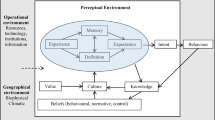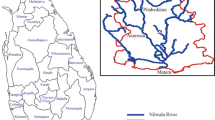Abstract
Since the 1970s, precipitation in the Sahel has decreased and become very irregular, leading to widespread drought, whilst the human need for water has rapidly increased. A new “dispositions”-based approach was adapted in order to analyse human interactions with environmental hazards and applied to the case of Hombori village in north-eastern Mali. This article explores how the population and political stakeholders perceive, live with and respond to the increasing scarcity of water. It also explores how their current vulnerability and ability to cope with variations in available water resources indicate future adaptability to climate shocks. On the one hand, this research shows how the population copes with variations in water resource availability: the population’s socio-spatial organisation explains the inhabitants’ exposure to this problem and some of the factors affecting vulnerability, the elderly and women being the hardest hit. The water issue is generally managed on a “day-to-day” basis and considered a big problem only in the dry season, thus lowering any incentive for self-protection. The main two variables that could explain this kind of risk management are the conflicting local governance and current social rules. On the other hand, the discussion of results, based on a conceptual model of social responses, explains why these current “social dispositions” to cope with and even address the water scarcity issue do not guarantee future adaptability to climate change.



Similar content being viewed by others
References
Adger WN (2003) Social capital, collective action and adaptation to climate change. Econ geogr 79(4):387–404
Adger N, Dessai S, Goulden M, Hulme M, Lorenzoni I, Nelson RD, Otto Naes L, Wolfand J, Wreford A (2009) Are there limits to adaptation to climate change? Clim Change 93:335–354
ANTEA (2005) Etude de faisabilité d’un programme d’hydraulique semi-urbaine dans la région de Mopti. Rapport de fin de phase 1: sélection des centres à équiper. ANTEA, Bamako
Bankoff G (2003) Cultures of disaster: society and natural hazard in the Philippines. Routledge, London
Bardin L (1977) L’analyse de contenu. Presses Universitaires de France, Paris
Becerra S (2012) Vulnérabilité, risques et environnement: l’itinéraire chaotique d’un paradigme sociologique contemporain. VertigO 12:1
Becerra S, Peltier A (2009) Risques et environnement: recherches interdisciplinaires sur la vulnérabilité des sociétés. L’Harmattan, Paris
Becerra S, Roussary A (2008) Gérer la vulnérabilité de l’eau potable: une action publique désengagée? Nat Sci Soc 16:220–231
Becerra S, Peltier A, Antoine JM, Labat D, Chorda J, Ribolzi O, Merlet N, Daupras F, Dartus D (2013) Comprendre les comportements face à un risque d’inondation modéré. Etude de cas dans le périurbain toulousain (Sud-Ouest de la France). Hydrol Sci J 58(5):945–965
Becerra S, Ghorbel M, Munoz M, Sappin-Didier V, Kolsi-Bensina N, Touati N, Mouri H (2015) “Comprendre la vulnérabilité sociale aux contaminations minières en Tunisie: exposition chronique et construction sociale des risques sanitaires » In: Béringuier P, Blot F, Desailly B, Saqalli M (ed) Environnement, politiques publiques et pratiques locales. L'Harmattan, Paris, France.
Bidou J-E, Droy I (2009) Décrire la construction temporelle des vulnérabilités: Observatoires ruraux et analyse historique des moyens d’existence dans le sud malgache. In: Becerra S, Peltier A (eds) Risques et environnement: recherches interdisciplinaires sur la vulnérabilité des sociétés. L’Harmattan, Paris, pp 155–170
Blaikie P, Cannon T, Davis I, Wisner B (1996) Vulnerabilidad. El entorno social, politico y económico de los desastres. Primera Edición, La RED. http://www.desenredando.org
Bourdieu P (2000) Les Structures sociales de l’économie. Seuil, Paris
Brooks N, Adger NW, Kelly MP (2005) The determinants of vulnerability and adaptive capacity at the national level and the implications for adaptation. Glob Environ Change 15:151–163
Burton I, Diringer E, Smith J (2006) Adaptation to climate change: International policy options. Pew Center on Global Climate Change, Arlington
Club du Sahel et de l’Afrique de l’Ouest (2008) Climat, changements climatiques et pratiques agro-pastorales en zone sahélienne. club du Sahel et de l’Afrique de l’Ouest/organisation de coopération et de développement economiques- comité inter-états de lutte contre la sécheresse au Sahel CILSS-Food and Agriculture Organization, Rome, Italy
Cournil C (2006) Vers une reconnaissance du réfugié écologique? Quelle(s) protections, Quel(s) statut(s)? Revue du Droit Public 4:1035–1066
Décamps H (2007) La vulnérabilité des systèmes socio-écologiques aux événements extrêmes: exposition, sensibilité, résilience. Nat Sci Soc 15:48–52
Dia AH, Becerra S, Gangneron F (2008) Crises climatiques, ruptures politiques et transformation de l’action publique environnementale au Mali. VertigO 8:1
Diamond J (2005) Collapse: how societies chose to fail or succeed. Viking, New York
Direction Nationale de l’Hydraulique du Mali (DNH) (2006) Rapport national sur la mise en valeur des ressources en eau: Mali. Etude préparée par le WWAP pour le deuxième rapport mondial des Nations Unies sur la mise en valeur des ressources en eau: l’eau une responsabilité partagée. Version finale, Bamako
Gado BA (1993) Une histoire des famines au Sahel: étude des grandes crises alimentaires (19ème-20ème siècle). L’Harmattan, Paris
Gaillard JC (2006) La culture comme enjeu majeur de la gestion des catastrophes liées à des phénomènes naturels au sein des sociétés traditionnelles. Géorisques 1:43–53
Gallais J (1975) Pasteurs et paysans du Gourma. La condition sahélienne, Centre National de la Recherche Scientifique
Gangneron F, Becerra S, Dia AH (2010) L’étonnante diversité des ressources en eau à Hombori: entre contrastes environnementaux, pratiques locales et technologies extérieures. Revue Tiers Monde 204:109–128
Gonin P, Lassailly-Jacob V (2002) Les réfugiés de l’environnement: une nouvelle catégorie de migrants forcés? Revue européenne des migrations internationales 18(2):139–160
Grothmann T, Patt A (2005) Adaptive capacity and human cognition: the process of individual adaptation to climate change. Glob Environ Change 15:199–213
Grothmann T, Reusswig F (2006) People at risk of flooding: why some residents take precautionary action while others do not. Nat Hazards 38:101–120
Holling CS (1973) Resilience and stability of ecological systems. Annu Rev Ecol Syst 4:1–23
IPCC (2014) Summary for policymakers. In: Climate change: impacts adaptation and vulnerability. Part A: global and sectoral aspects. Contribution ok working group II to the fifth assessment report of the IPCC. Field, C.B., V.R. Barros, D.J. Dokken, K.J. Mach, M.D. Mastrandrea, T.E. Bilir, M. Chatterjee, K.L. Ebi, Y.O. Estrada, R.C. Genova, B. Girma, E.S. Kissel, A.N. Levy, S. MacCracken, P.R. Mastrandrea, and L.L. White (Eds.), Cambridge University press, Cambridge United Kingdom and New York, N.Y., USA, pp 1–32
Janin P (2007) Marginalité, vulnérabilité et pratiques de survie en période de soudure alimentaire. In Proceedings of the Colloque Dynamiques de pauvretés et vulnérabilités, Louvain-la-Neuve (Belgium)
Lahire B (2001) L’homme pluriel. Les ressorts de l’action, (Nathan, 1998 réédité en poche). A. Colin/Nathan, collection Pluriel, Paris, p 392
Le Barbé L, Lebel T (1997) Rainfall climatology of the HAPEX-Sahel region during the years 1950–1990. J Hydrol 188–189:43–73
Mougin E, Hiernaux P, Kergoat L, Grippa M, de Rosnay P, Timouk F, Le Dantec V, Demarez V, Lavenu F, Arjounin M, Lebel T, Soumaguel S, Ceschia E, Mougenot B, Baup F, Frappart F, Frison PL, Gardelle J, Gruhier C, Jarlan L, Mangiarotti S, Sanou B, Tracol Y, Guichard F, Trichon V, Diarra L, Soumaré A, Koité M, Dembélé F, Lloyd C, Hanan NP, Damesin C, Delon C, Serça D, Galy-Lacaux C, Seghieri J, Becerra S, Dia AH, Gangneron F, Mazzega P (2009) The AMMA CATCH Gourma Observatory site in Mali: relating climatic variations to changes in vegetation, surface hydrology, fluxes and natural resources. J Hydrol 375(1–2):14–33
Observatoire du Développement Humain Durable (ODHD) (2005) Rapport sur le développement humain au Mali: gestion de l’environnement pour un développement humain durable. United Nations Development Program, New York
Paavola J (2008) Livelihoods, vulnerability and adaptation to climate change in Morogoro, Tanzania. Environ Sci Policy 11:642–654
Pelling M (2003) The vulnerability of cities. Natural disasters and social resilience. Earthscan Publications, London
Revet S (2009) De la vulnérabilité aux vulnérables: approche critique d’une notion performative. In: Becerra S, Peltier A (eds) Risques et environnement: recherches interdisciplinaires sur la vulnérabilité des sociétés. L’Harmattan, Paris, pp 89–99
Sakdapolrak P (2007) Water related health risk, social vulnerability and Pierre Bourdieu in Warner K. perspectives on social vulnerability, Publication Series of UNU-EHS 50–60
Simonet G. and S. Fatoric (2015) Does ‘‘adaptation to climate change’’ mean resignation or opportunity? Regional environmental change, published online: http://link.springer.com/article/10.1007/s10113-015-0792-3/fulltext.html
Slovic P (2002). Perception of risk posed by extreme events. Discussion at the conference “risk management strategies in an uncertain world. Palisades, New York, April 12–13
Thomas H (2008) Vulnérabilité, fragilité, précarité, résilience etc. De l’usage et de la traduction de notions éponges en sciences de l’homme et de la vie. TERRA-Ed., collection Esquisses [online] http://terra.rezo.net/article697.html
Totté M, Dahou T, Billaz R (2003) La décentralisation en Afrique de l’Ouest, entre politique et développement. Editions Karthala, Paris
Tschakert P (2007) Views from vulnerable: understanding climatic and other stressors in the Sahel. Glob Environ Change 17:381–396
Walker B, Carpenter S, Anderies J, Abel N, Cumming G, Janssen M, Lebel L, Norberg J, Peterson GD, Pritchard R (2002) Resilience management in social-ecological systems: a working hypothesis for a participatory approach. Conserv Ecol 6 (1):14. [online] http://www.consecol.org/vol6/iss1/art14
Walker BH, Salt D (2006) Resilience thinking: sustaining ecosystems and people in a changing world. Island Press, Washington
Weber EU (1997) Perception and expectation of climate change: precondition for economic and technological adaptation. In: Bazerman MH, Messick DM, Tenbrunsel A, Wade-Benzoni K (eds) Psychological perspectives to environmental and ethical issues in management. Jossey-Bass, San Francisco, pp 314–341
Wisner B, Blaikie P, Cannon T, Davis I (2004) At risk: natural hazards, people’s vulnerability and disasters, 2nd edn. Routledge, New York
Acknowledgments
This work was performed within the framework of two projects: 1—the African Monsoon Multidisciplinary Analyses project (AMMA), funded by a number of agencies from France, the UK, the US and Africa, with a major financial contribution from the European Union Sixth Framework Research Programme (http://www.amma-eu.org/ ), and 2—The Elevage CLImat Société (ECLIS) project, funded by the French National Research Agency (ANR).
Author information
Authors and Affiliations
Corresponding author
Additional information
Communicated by James D. Ford.
Rights and permissions
About this article
Cite this article
Becerra, S., Saqalli, M., Gangneron, F. et al. Everyday vulnerabilities and “social dispositions” in the Malian Sahel, an indication for evaluating future adaptability to water crises?. Reg Environ Change 16, 1253–1265 (2016). https://doi.org/10.1007/s10113-015-0845-7
Received:
Accepted:
Published:
Issue Date:
DOI: https://doi.org/10.1007/s10113-015-0845-7




